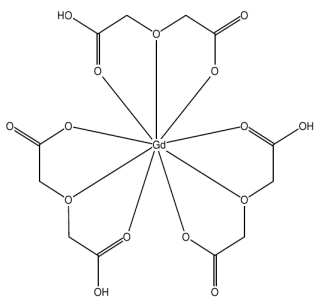pKa of hydrogen atoms attached to oxygen atoms of the ligands can be computed from PM6 sparkle model calculations. For an explanation of the method, please review
- To perform this task you will need the following softwares: MOPAC2012, and a text editor of your preference (Notepad, Textpad, etc.).
- As an example, let us consider the complex TUFLUB [tris(Hydrogen oxydiacetate)-gadolinium(iii)], bellow:

- First draw and optimize the geometry of your complex following the instructions in Drawing Complexes. You should now have the corresponding .mop and .arc files. As an example, we provide the tuflub.mop.
- Convert the .arc file, tuflub.arc, generated by MOPAC2012 into a new and optimized .mop file using your favorite text editor. Open the .arc file and save it with another name with the .mop extension. Find the line which reads FINAL GEOMETRY OBTAINED and remove everything above and including this line.
- Replace the keywords AM1 or PM3 by the keyword PM6, and add the keyword pKa.
- Save the file as a .mop file with another name. For convenience we provide tuflub_opt.mop.
- Run this new .mop file in MOPAC2012. An .out file with the same name will be created.
- If you run into any problems, please review the warning in the bottom part of the tutorial Drawing Complexes.
- The predicted pKa for hydroxyl hydrogens appear in the .out file, as below:
FINAL HEAT OF FORMATION = -671.39315 KCAL = -2809.10892 KJ TOTAL ENERGY = -6091.69312 EV ELECTRONIC ENERGY = -46909.16320 EV POINT GROUP: C3 CORE-CORE REPULSION = 40817.47009 EV COSMO AREA = 343.80 SQUARE ANGSTROMS COSMO VOLUME = 427.65 CUBIC ANGSTROMS pKa for hydroxyl hydrogens Sorted by pKa Sorted by atom Atom pKa Atom pKa 42 -2.654 36 -2.652 36 -2.652 39 -2.640 39 -2.640 42 -2.654 - For convenience we provide tuflub_opt.out.
- The accuracy of prediction of pKa using this methodology can be checked in the MOPAC site.